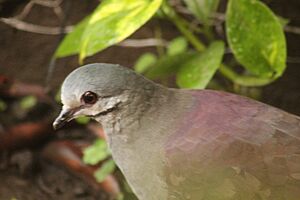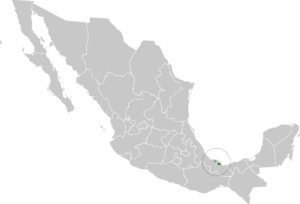Tuxtla quail-dove facts for kids
Quick facts for kids Tuxtla quail-dove |
|
|---|---|
 |
|
| Conservation status | |
| Scientific classification | |
| Genus: |
Zentrygon
|
| Species: |
carrikeri
|
 |
|
| Synonyms | |
|
Geotrygon carrikeri |
|
The Tuxtla quail-dove is a special kind of bird that lives only in a small part of southeastern Mexico. It is also known as the Veracruz quail-dove. This beautiful bird is part of the Columbidae family, which includes all the pigeons and doves.
Contents
About This Bird's Family
The Tuxtla quail-dove is a unique species. This means it is the only one of its kind in its group. Long ago, scientists thought it was the same species as another bird. That bird is called the purplish-backed quail-dove, which lives in Central America. But now, they know they are different species.
What Does It Look Like?
The Tuxtla quail-dove is about 20 to 31.5 centimeters (8 to 12 inches) long. That's about the length of a ruler!
Adult birds have a light bluish-gray color on their head, neck, throat, and chest. Their sides are light brown. They also have a wide black stripe on their cheek area. Their back and wings are an olive-brown color. They don't have much shimmer or shine.
Young Tuxtla quail-doves look a bit different. They are darker all over. Their upper feathers have cinnamon-colored edges. They also have buff-colored bars on their chest.
Where Does It Live?
The Tuxtla quail-dove lives in a very specific place. It is found only on two volcanoes in southeastern Mexico. These volcanoes are called Volcán de San Martín and Sierra de Santa Marta. Both are located in the Sierra de los Tuxtlas mountains in Veracruz state.
This bird likes to live in wet, green forests. These are called evergreen forests and cloudforests. These forests are found high up in the mountains. The birds live at elevations between 350 and 2,100 meters (about 1,150 to 6,900 feet).
How Does It Behave?
Feeding Habits
The Tuxtla quail-dove usually looks for food alone or in pairs. We don't know all the details about what it eats. But scientists think it probably eats fruits, seeds, and small bugs. It finds these things by searching through the fallen leaves on the forest floor.
Reproduction
Scientists have only found one Tuxtla quail-dove nest so far. This nest was built loosely, like a platform. It was supported by bamboo shoots. The nest contained just one egg.
What Does Its Song Sound Like?
The Tuxtla quail-dove has a special song. It sounds like "whu-hu-whUuuw". The last part of the song, "whUuuw", is the loudest and most important part. If you are far away, you might only hear that last sound.
Why Is It Endangered?
The IUCN (International Union for Conservation of Nature) has listed the Tuxtla quail-dove as an Endangered species. This is because it lives in a very small area. This area has also lost almost all of its forests. This loss of habitat makes it very hard for the birds to survive.


